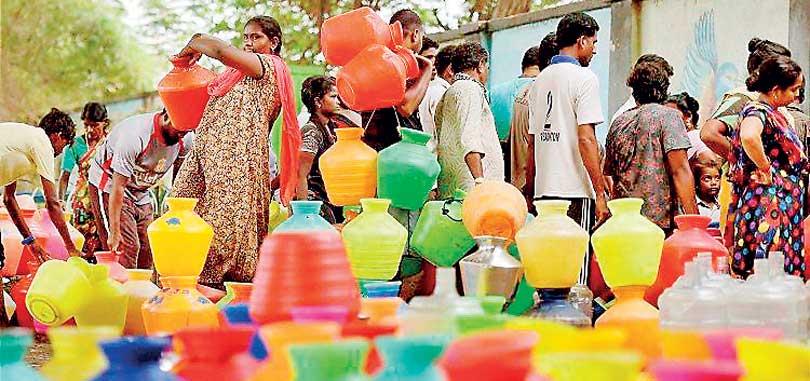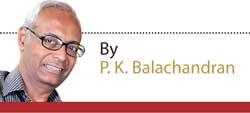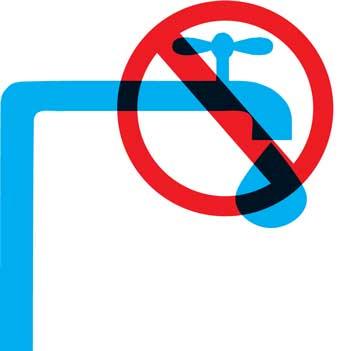Reply To:
Name - Reply Comment

People queue up to collect water
 The water crisis in India is not only huge, but is multi-dimensional, and therefore, very complex. The crisis spans urban and rural areas and surface and underground water sources.
The water crisis in India is not only huge, but is multi-dimensional, and therefore, very complex. The crisis spans urban and rural areas and surface and underground water sources.
Water harvesting is either absent or ineffective. Then there are, of course, wastages, leakages and inequities in distribution.
The Indian government had declared that every Indian household will get piped water by 2024. This is clearly unrealistic given the fact that there is a tremendous shortage of water. And the quantum of water is not likely to increase. It will only decrease given the natural rise in demand due to an increase in the population and also to an increase in urbanization.
 There is also an entrenched and almost habitual lack of interest in water conservation and better water usage, due to poor political leadership, an unimaginative administration and the existence of vested interests which want the current iniquitous access to water to continue.
There is also an entrenched and almost habitual lack of interest in water conservation and better water usage, due to poor political leadership, an unimaginative administration and the existence of vested interests which want the current iniquitous access to water to continue.
According to Mahreen Matto of the Centre for Science and Environment, New Delhi, 330 million of India’s 1.2 billion people (a quarter of India’s population), are affected by a severe drought due to the failure of the monsoon for two consecutive years.
Nearly 50% of India, especially in the Western and Southern States, are afflicted by drought. Twelve per cent of India’s population is already living the ‘Day Zero’ scenario, due to excessive groundwater pumping, an inefficient and wasteful water management system and years of deficient rains, Matto says.
 The Composite Water Management Index (CWMI) released by the Indian government’s think tank “Niti Aayog” in 2018, states that by 2030, India’s demand for water will be twice the available supply, implying severe water scarcity for hundreds of millions of people.
The Composite Water Management Index (CWMI) released by the Indian government’s think tank “Niti Aayog” in 2018, states that by 2030, India’s demand for water will be twice the available supply, implying severe water scarcity for hundreds of millions of people.
The shortage is expected to create a 6% loss in the country’s GDP.
Twenty one major Indian cities, including Delhi, Bengaluru, Chennai and Hyderabad, are racing to reach zero groundwater levels by 2020, affecting access to water for a total of 100 million people, Matto warns.
“We value land more than water, neglecting our local water bodies, which have either gone dry or are encroached,” Matto points out.
Aggravating the problem is the fact that the water being supplied currently is of drinking water standard. This is nothing but a grave misuse and a criminal waste of treated water.
Besides, 80% of water that reaches households, leaves as waste and pollutes water-bodies out and the environment. There is a huge potential in reusing and recycling wastewater at least for non-potable purposes. But little or nothing is done in this regard, Matto regrets.
Then there are issues such as leakage, uneconomic water pricing and poor metering of supply. Water rates are low because water supply is in the government sector and is seen as a social and political service to the common man.
It would be tolerable if cheap water supply is accompanied by a sensible use of water sans wastage, but free or cheap water is taken as a license to waste. Municipal hydrants overflowing with no one bothering to plug them is a common sight in Indian cities.
Lack of proper maintenance of existing water supply infrastructure causes further losses. Almost 40% of piped water in urban areas is thus wasted, Matto points out.
It is time Indians went back and started using traditional practices of rainwater harvesting — catching water where it falls. Presently, India catches only 8% of its annual rainfall, among the lowest in the world, she observes.
Besides, 80% of water that reaches households, leaves as waste and pollutes water-bodies
Groundwater Over Exploitation
A Reuters Graphics report by Gurman Bhatia says that more than 200 million people in India live in places that are over-exploiting groundwater. That is equivalent to the entire population of Brazil, he points out.
Groundwater has been declining at an alarming rate in India, Bhatia asserts. “India’s water stress has increased in the last few decades as bore wells were dug to extract more and more groundwater for water-guzzling crops such as rice and sugarcane,” Bhatia says.
“Several water-stressed districts have become rapidly growing urban centres where groundwater ends up being the fallback to meet increasing demand amidst the lack of adequate sources.”
“Government data released in July 2019 shows that in 2017, 109 districts out of the 684, for which data was available, used more groundwater than what was replenished by both natural and artificial processes.”
“Data published by India’s Central Ground Water Board suggests that when city and village blocks were compared to the last review done in 2013, fewer blocks recorded safe levels in 2017. The percentage of overexploited blocks increased,” Bhatia points out.
Interestingly, India’s groundwater usage exceeds that of China and the United States combined.
Bhatia says that in India, the per capita water availability had fallen to 1,545 cubic metres in 2011 from 5,177 cubic metres in 1950. Less than 1,700 cubic metres water availability is considered a “water-stressed” condition, whereas below 1,000 cubic metres is considered as a “water scarcity” condition. Availability in India is forecast to drop below 1,300 cubic metres by 2041.
330 million of India’s 1.2 billion people (a quarter of India’s population), are affected
Meera Subramaniam, author of “A River Runs Again: India’s Natural World in Crisis, From the Barren Cliffs of Rajasthan to the Farmlands of Karnataka,” says that the water which is available is poorly managed.
Writing in New York Times, Subramaniam points out that India has always been vulnerable to the vagaries of the monsoons that provide 70% of the water in a few months. The monsoons feed its rivers, recharge its groundwater and top off the Himalayan peaks whose glacial melt water sustains 1.65 billion people.
Referring to the recurring water crisis in Chennai, the capital of Tamil Nadu, Subramaniam says: “About half of the 6,000 water bodies that once defined Chennai and its two neighbouring districts are gone. Rampant development has destroyed the spaces that were natural sponges for monsoon rains.”
In many areas in Chennai, a city of eight million people, water is still purchased and the price per tanker has doubled in comparison with the previous crisis. As expected, the poor who have no means to buy enough water, make do with very little of it. They depend on the tankers of the municipality.
According to Subramaniam, large dams to store water are not the answer to the water problem. India needs numerous small-scale, nature-based efforts to seize the seasonal monsoonal bounty, she says.
In Rajasthan, villagers have built thousands of small earth dams called “johads” These dams fill the aquifers (layers of water-permeable rock). Wells that had been dry for a generation bubbled back into existence.
In Kumbharwadi in Maharashtra, local villagers planted trees and sculpted the land to capture water across the landscape. And as a result of these efforts, “ground water levels rose, soil fertility improved, and agricultural income increased tenfold,” Subramaniam points out.
She does not recommend desalinization, which is being tried out in Chennai. It is not only expensive but environmentally disastrous, she says.
Mahreen Matto points out that water is not equitably distributed. This is a social, economic and political problem. The well to do and the politically connected get an abundant supply and the poor and the socially marginalized get much less.
The Indian government had declared that every Indian household will get piped water by 2024
“Some areas of mega cities like Delhi and Mumbai are privileged to get more that than the standard municipal water norm of 150 litres per capita per day (lpcd) while other areas get 40-50 lpcd,” she points out.
In the urban areas, lack of proper maintenance of infrastructure causes a 40% loss of piped water.